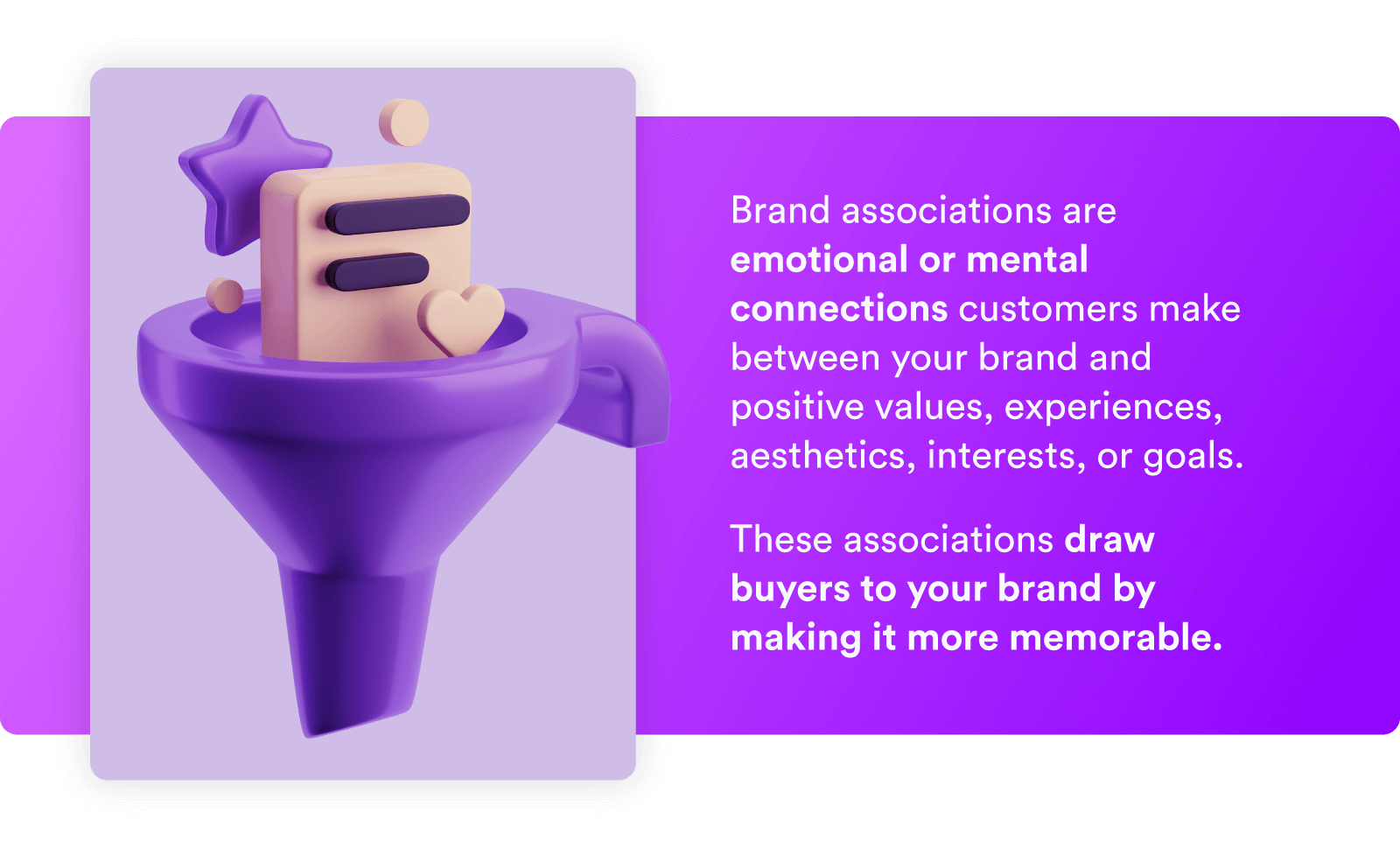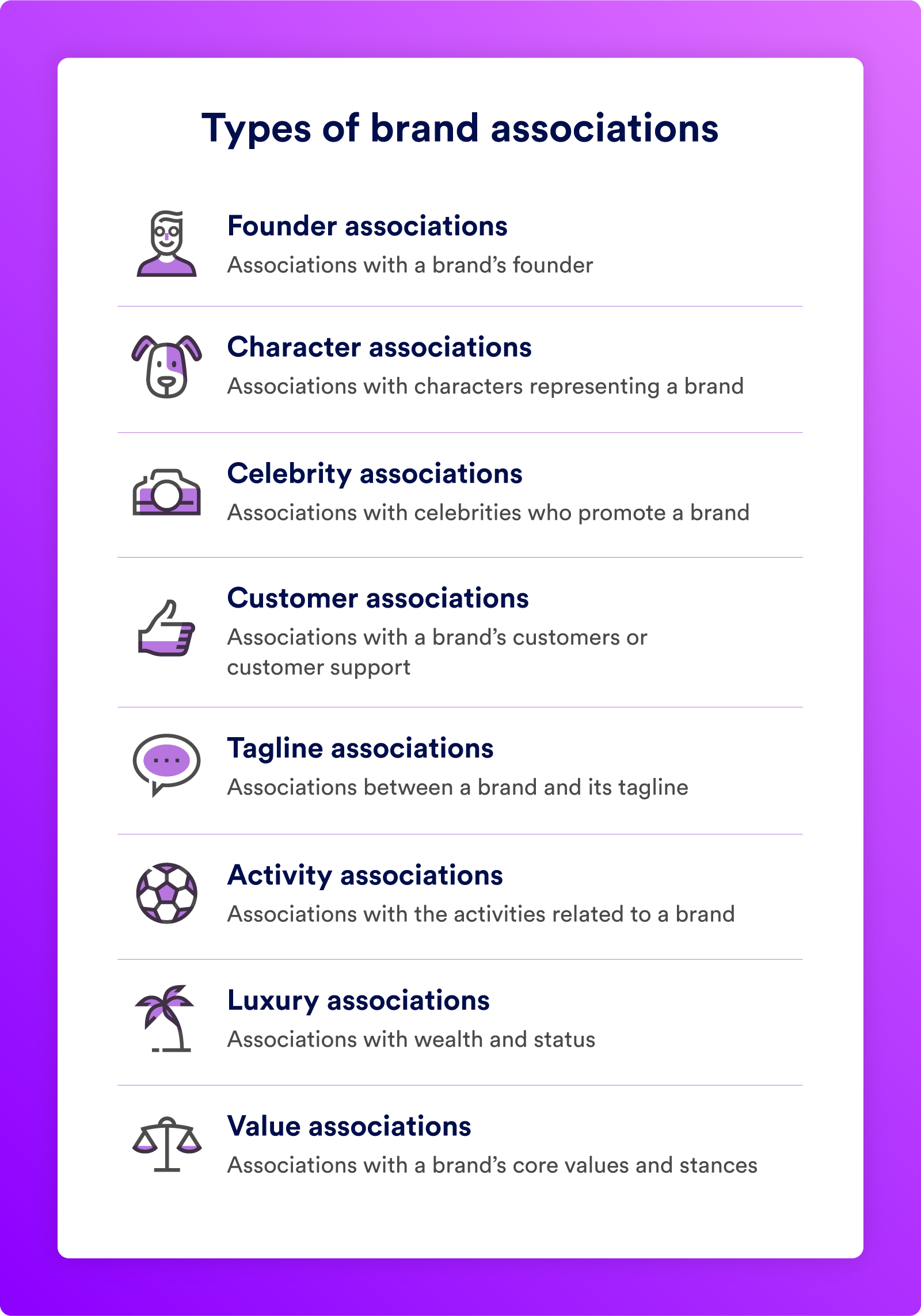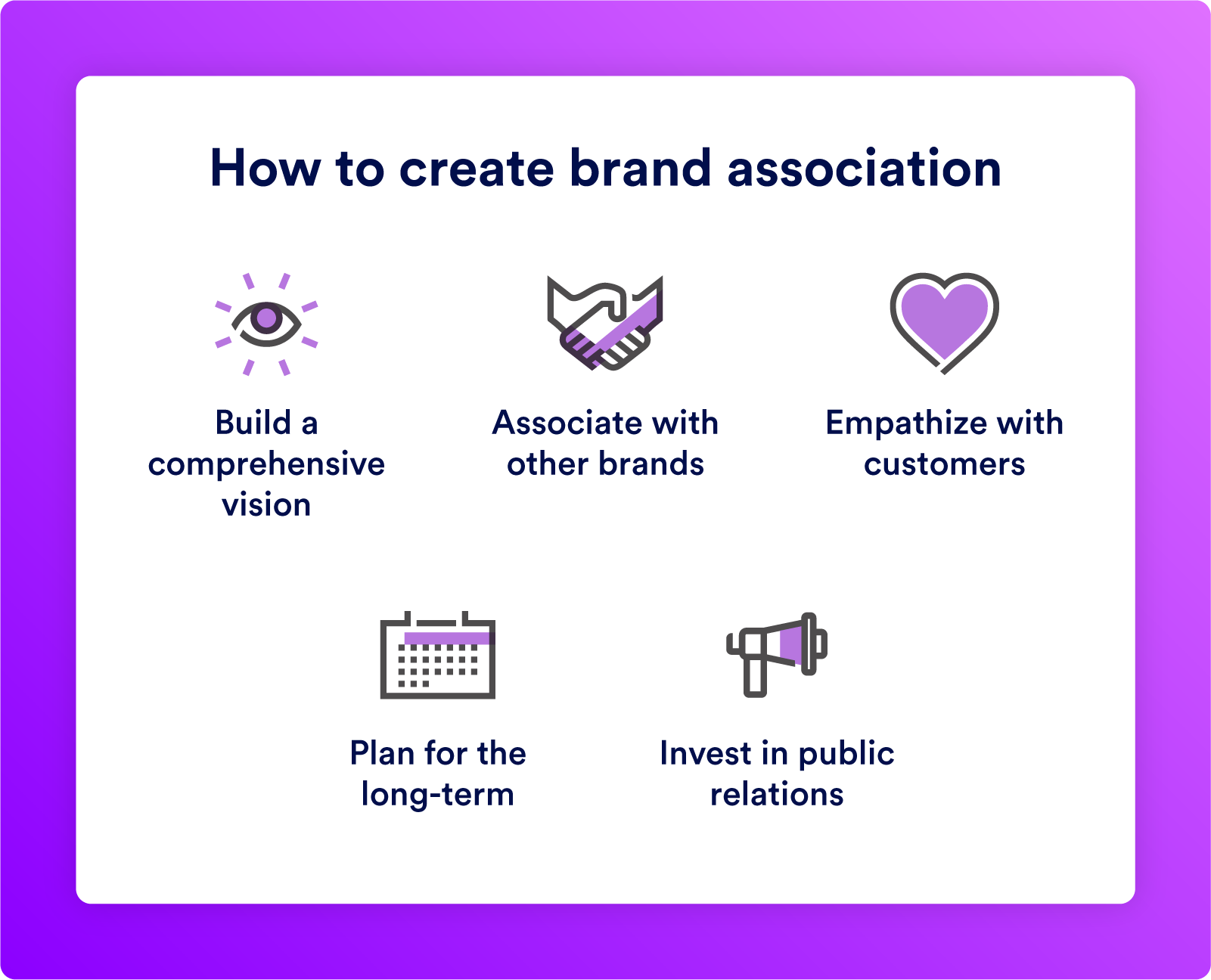Get branding tips and expert advice delivered straight to your inbox.
How do you turn a sale or branding opportunity into a lifelong customer relationship? Offering a great product helps, but the most memorable brands foster connections with their audience. Whether it’s over a shared value, an emotional experience, or a great tagline, a strong connection helps you go above and beyond. For that, you can try brand association.
Brand associations are the psychological connections buyers draw between your brand and values, feelings, and outcomes. With positive brand associations, customers will naturally resonate with your identity. In this article, we’ll explain the different types of brand associations and how to create positive associations.
What Is Brand Association?
A brand association is a mental or emotional connection customers make with your brand. Customers draw these connections between your brand pillars and specific values, aesthetics, emotions, and interests. While brand associations aren’t all positive, they help your company stand out and stay memorable.
For example, many customers connect Coca-Cola with the impression that it’s a “classic,” the gold standard for soda. You can also make associations based on the product itself. Tesla leverages “electric” as a brand association when promoting its cars as eco-friendly, and Downy projects comfort and softness in its branding.

Many positive brand associations can come from a company’s:
- Mission statement
- Products and services
- Reputation in the field
- Marketing
- Customer base
Why Is Brand Association Important?
Brand associations help you stand out from competitors and attract customers who are open to the connections you elicit. They reinforce your brand identity, tying personal feelings to your product or service. At its best, a positive association improves brand loyalty by making a brand more recognizable and memorable. Positive brand associations offer:
- Brand Awareness: Associations make your brand more recognizable. As customers remember your brand identity, they may keep up with new releases or spread the word about you.
- Customer Loyalty: A positive brand association fosters connections with customers. If they identify with a brand, they may stick with it longer.
- High-Quality Associations: Customers who recognize a brand may associate its popularity with quality. This gives recognizable brands more authority in their field.
- A Competitive Edge: Brand associations help you stand out from competitors. If you come to buyers’ minds first, that’s one less customer for your competitors.
Elements of Brand Association
Brands build associations from strategic choices, taglines, aesthetics, and more. Companies don’t need a set list of assets to make brand associations. Instead, they can build these connections with tools that are likely already at their disposal.
Here are the most common elements that create brand association:
- Iconic Visuals: A logo, choice of color, or overall aesthetic can build associations with your brand.
- Branded Language: Your word choice, taglines, and tone can foster brand associations.
- Personality: An identity or series of core adjectives can sum up your brand.
- Context: Whom you partner with or where you stand in the field can promote associations.
Pro tip: Your brand elements don’t need to feel showy or over the top. Instead, they need to reflect your brand identity. To find an angle customers identify with, try writing customer personas. By looking at buyers holistically, you can see how these elements should come together and resonate with them.
Types of Brand Associations
Brands can make different associations based on their strengths or target market to appeal to broader groups of customers. Some of the most popular types include:

- Founder Associations: Company founders present a face defining the brand associations they want to build. For example, Apple Founder Steve Jobs associated his company with innovation.
- Character Associations: Fictional characters and mascots set the tone for a brand. Disney imbues a lot of its brand identity in characters like Mickey Mouse.
- Celebrity Associations: Celebrities spread brand associations when they endorse or create a product. For example, Robert Pattinson endorsed Dior to promote its designs.
- Customer Associations: Brands often make associations based on customer personas. Harley-Davidson markets itself to customers who value adventure and individualism, similar to the brand itself.
- Word or Tagline Associations: Many brands write taglines that sum up their intended associations. Nike’s “Just do it” ties into its core identity.
- Activity Associations: Many brands market their products around specific activities. Gatorade advertising usually frames its drink around sports and high performance.
- Luxury Associations: Brands associated with luxury standards can attract more attention or respect. Brands like Versace and Rolex associate luxury with their products.
- Value Associations: Brands can endorse social values or political stances to build value associations, like when Lyft supported the American Civil Liberties Union in 2018.
What Is a Brand Association Map?
Brand association maps are a visual representation of the associations around your brand, like a brand pyramid. They show how customers position your brand in the broader market by mapping out all the possible connections and help you brainstorm new ones. You can also make brand association maps for your competitors to analyze their strategies and reach.

Challenges To Building a Positive Brand Association
With brand associations, not all publicity is good publicity. Even if you build a memorable brand, it won’t necessarily attract customers. In some cases, negative brand associations can push them away. So, to make the best brand associations, prepare for these challenges:
- Outdated Assets: As your brand identity changes, associations need to change with it. As you introduce new products and bring in new customers, ensure your assets all fit together.
- Unclear Vision: Customers can’t make associations if they aren’t sure what your brand is going for. Establish a clear style and voice and implement it across all brand channels.
- Poor Brand Strategy: You may have a distinct vision you can’t execute. To foster associations, try projecting your brand through different assets like video, web design, and social media image sharing.
- Miscommunication: An internal or external lack of alignment can miscommunicate what your brand stands for. Keep your messaging simple to create consistent associations.
How To Create Brand Associations
With so many types of brand associations to choose from, you may need help figuring out where to start. While there’s no template for creating lasting customer connections, that allows you the freedom to experiment. Instead of following guidelines, try multiple strategies.

Build a Comprehensive Vision
Avoid selectively creating brand associations with certain parts of your brand. Instead, you need a holistic vision reflecting your entire enterprise. This way, customers can make your intended associations at any entry point. Additionally, comprehensive branding will keep your tone consistent.
You can build this vision with a wide library of brand assets sharing the same voice and message. With brand asset management, you can organize all your assets in one place. From there, your team can easily find and tweak assets over time.
Associate With Other Brands
Creating partnerships streamlines the process of building positive brand associations. You can form these relationships with other brands, influencers, and content creators. A great partnership needs two companies with complementary offerings, like Apple and Nike. These two brands teamed up in 2006 to create the Apple Watch Nike+, a tool that seamlessly integrated Apple's technology with Nike's expertise in fitness and sports.
To make positive associations with partnerships, you can:
- Collaborate on a new product or service.
- Publicize your commitment to a shared cause.
- Conduct industry research and publicize it together.
Keep in mind that partnering with the wrong brand can prevent positive associations. You want to partner with companies that have similar values to your own to make the partnership more authentic. In some cases, partnering with a well-liked company is enough to boost positive associations.
Empathize With Customers
Just because your branding strategy makes sense internally doesn’t mean customers will connect with it. So, embed positive associations in the way you interact with customers. For example, TOMS has a "one for one" business model, where the company helps someone in need with every product purchased. This socially responsible approach has resonated well with customers and showcases the company's empathy.
Treat your customers like members of a community. Whether interacting through social media or live events, see yourself through the customers’ eyes. Remember, customers are advocates for your brand associations. You can’t sell them an association, but if you prove your authenticity, they will likely make those connections themselves.
Plan for the Long Term
Choices you make as a business have long-term ramifications that affect your brand. Brand assets made in poor taste can haunt your reputation well after you take them down. When weighing strategic decisions, you can’t only think one quarter ahead.
You also need to prepare for public relations issues. Past partnerships or outdated materials may not reflect your current position. While you should make sure every choice stands the test of time, having a crisis management plan in place will help you quickly respond to issues without jeopardizing your brand.
Invest in PR
When your brand doesn’t make the right associations, PR can help improve your company’s appearance and help keep you on message. Even when your branding hits the right notes, solid PR can help you stand out from the crowd. It can also offer new ways to boost engagement and evoke the right emotions and connections.
Specifically, PR can improve brand associations by:
- Refining your marketing strategy
- Researching how customers engage with your brand
- Brainstorming new promotion and partnership opportunities
- Changing your tone and messaging to reflect your best values
Brand Association Examples
Great brand associations are so ingrained in customers' minds you might not even notice them. To pinpoint how brand associations work in practice, here are a few well-known examples:
- A Ferrari is fast and luxurious. Ferrari’s logo and models' sleek designs emphasize speed and freedom. High-profile customers like Kim Kardashian and Arnold Schwarzenegger also elevate the brand’s status.
- Disney emphasizes enchantment and nostalgia. Disney builds positive associations by tying its brand to beloved characters in pop culture. It builds parks designed to enchant visitors and make them feel like they’re in a fairy tale.
- HBO is edgy and prestigious. Its brand name, “Home Box Office,” implies a level of prestige you can’t usually find on TV. Additionally, the network’s shows cover subject matter other channels were afraid to touch for decades.
Make Connections and Brand Associations With Brandfolder
A brand’s value depends on more than what it offers customers. The values you represent, the brand partnerships you build, and the vision you share create vital brand associations. With the right customer connections, you don’t only get a competitive edge — you create a connection leading to a lifelong relationship with your customers.
Establishing a cohesive brand asset library to help you build better brand associations is easy with Brandfolder by Smartsheet. Brandfolder gives you total control over your assets to ensure you can switch or update them at any time. Our analytics also generate reports on the success of each asset to help adjust your approach. Schedule a demo and get started managing your assets and maintaining brand consistency today.
